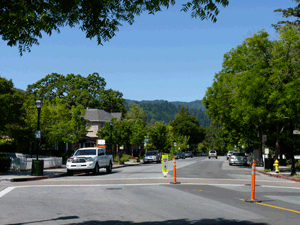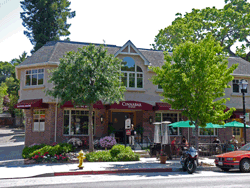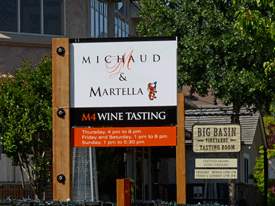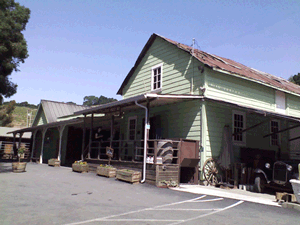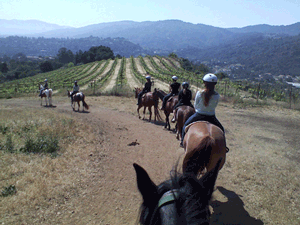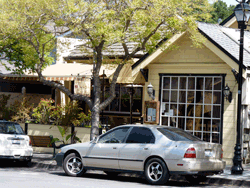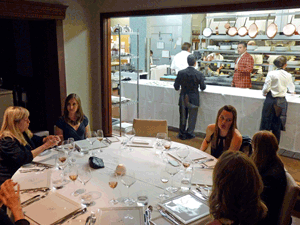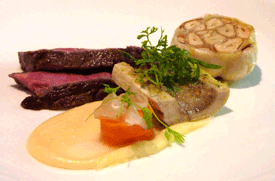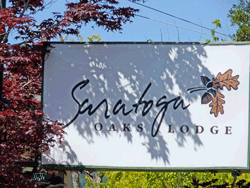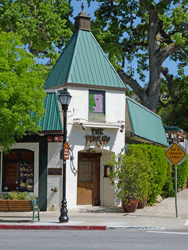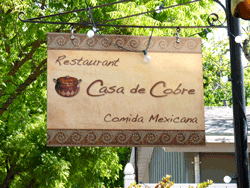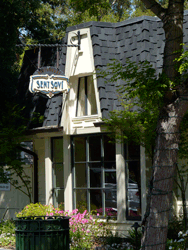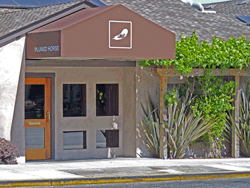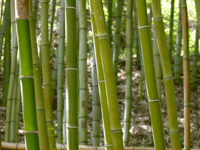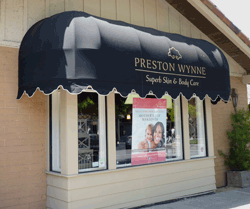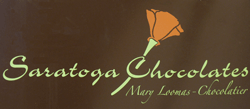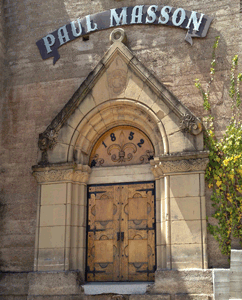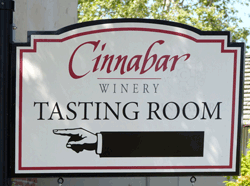(Favorite Day Trips from San Francisco — Part Three)
text and photos ©2013
The San Andreas Fault, where the North American Plate meets the Pacific Plate, runs through the Santa Cruz Mountains, which separate San Francisco Bay from the Pacific Ocean. San Francisco lies at the northern end of the mountains, San Jose near the southern end. During the Spanish era San Francisco was connected to San Jose by El Camino Real, The Royal Road, which linked all of the missions in California from Sonoma to San Diego, each a day’s ride from the next.
When the United States annexed Alta California in 1846, a stage line was established along this dirt track, and at each stage stop little towns sprang up. In 1850 the 45-mile journey between San Francisco and San Jose took six hours at a cost of $30. The line ran three times a week during the dry months when it was possible to ford the numerous streams that ran off the sides of the mountains. By 1864 passengers could make the trip in two hours by rail, at the cost of just $2.
The towns on the peninsula grew slowly over the next 80 to 90 years. Up to the 1950’s Santa Clara Valley, from the southern tip of the bay down to Hollister, remained rural and was renowned for its wine grapes, abundant orchards, and 39 fruit canneries. Urbanization in the 1950’s and ‘60’s paved over much of the northern end of Santa Clara Valley, and it became known as Silicon Valley. Like the song says, “They paved paradise and put up a parking lot.”
In 1982 I had dinner at Mount Eden winery with Eleanor Ray, widow of Martin Ray who founded Mt. Eden after selling the Paul Masson winery above Saratoga. As darkness fell we looked out on a carpet of lights that spread out on the valley floor to the dark edge of San Francisco Bay. “I can remember,” she said, “when I first came up here in the 1940’s I could pick out the farms down there by their lights, and I knew all of them by name.”
Today El Camino Real is a four lane boulevard, and a train still runs between San Jose and San Francisco, but in the automobile era most commuters ply highway 101 that carries traffic along the flats at the edge of the bay, and Interstate 280 that runs a parallel route along the flanks of the mountains. The little towns have spread out like blobs of oil paint, one running into the next in a contiguous sprawl the entire length of the peninsula.
Being off the north-south corridor and at the edge of the forest, the village of Saratoga retains some of the quiet charm of days gone by, and is a great place to explore on foot, to shop leisurely, relax at a day spa, ride horseback, stroll Japanese gardens, eat casually or lavishly, taste wine or take in a concert. For the epicurean traveler Saratoga is a cornucopia of possibilities.While some of these towns possess a certain suburban appeal (indeed, some of the country’s most expensive real estate can be found here), the unbroken chain of business that stretches for 50 miles along El Camino Real presents a monotonous and dreary clutter of signage for the weary traveler’s eyes. Nonetheless, despite the increase in population and its attendant frenzied pace, the mountains themselves remain largely wild, and offer rural respite within minutes of the crowds.
Highway 9, which becomes Big Basin Way as it runs through Saratoga, is a gateway to the 70 wineries within the Santa Cruz Mountains appellation, but you don’t have to leave town to taste wine. If you were to stay at the Saratoga Oaks Lodge (rated number one by Trip Advisor), you would be next door to three tasting rooms.
tasting buddy of mine. Tom was tall and thin, with a deep voice and a good sense of humor, not to mention a fine palate. The winery has passed to the next generation, but his vision remains, and the wines are excellent, drawing from vineyards in the Santa Cruz Mountains, Monterey and Lodi.The first is Cinnabar Winery Tasting Room. Cinnabar was founded by Tom Mudd, an old wine
In the next building you’ll find Big Basin Vineyards Tasting Room. Big Basin has estate vineyards in the Santa Cruz Mountains, and buys from other vineyards in the Santa Cruz Mountains, and from the Gabilan range further south in Monterey County.
Next door to Big Basin, is the combined tasting room of Martella Winery and Michaud Vineyards. Martella sources its wines both locally and from vineyards as far-flung as Mendocino, Sonoma and Amador counties, with an emphasis on Rhone varieties, while Michaud Vineyard
specializes in Pinot Noir and Chardonnay grown in the Chalone appellation in Monterey County.
A block and a half down the street will bring you to Ruthe Roberts Vintners Collective, a wine tasting room shared by eleven small wineries.
So without even leaving the village you can sit inside or out on one of the decks and enjoy a wide range of wines from fifteen different producers, along with hors d’oeuvres, as well as live music on the weekends.
If you’re just a little more adventurous and would like to visit a working winery, continue up the highway just a couple of miles to Cooper • Garrod Estate Vineyards. The Garrod family has lived
Just a little further up highway 9 you’ll arrive at The Mountain Winery, Paul Masson’s historic winery and chateau that has since 1959 hosted a famous Summer Concert Series. Though winemaking operations were moved off-premise more than 60 years ago, the current owners realized the potential in the property and have replanted to Pinot Noir and Chardonnay, the Burgundian varieties first cultivated here by Paul Masson, and his protégé Martin Ray. The Mountain Winery’s harvest is now vinified at nearby Mount Eden Winery, which was founded in the 1940’s by Martin Ray after he sold Paul Masson to Seagram’s. So history comes full circle. On days when there are no special events, you can have your glass of wine with a panoramic view of the South Bay from the deck. I was particularly impressed by the Pinot Noir.on the mountain since 1893, along with their Cooper cousins since the 1930’s. The families grew prunes until the local distribution channels dried up as the northern end of Santa Clara Valley was paved over. They then transitioned the
125-acre property into an equestrian center, and today board about 120 horses, and own another 50 that they rent out. There you can ride trails over the hills and through the vineyards above Saratoga. The first vineyards were planted in 1972 as a retirement project for NASA test pilot George Cooper, who sold grapes to local wineries and made wine for family consumption. The commercial winery was established in 1994, 101 years after the Garrods moved onto the mountain. Today Jan Garrod looks after 28 acres of certified organic, dry-farmed grapes that cousin Bill Cooper (George’s son) turns into 2,500 cases of wine annually. You can taste the wines daily from noon to 5 p.m., and Bill leads a vineyard and winery tour on the first Saturday of each month. I’ve rarely been more impressed by a line-up of wines. Bill Cooper has a knack for creating classically proportioned wines with distinct varietal definition and nuance.
Of course man does not live by drink alone — a little food is required between drinks — and Saratoga village, despite its diminutive size, has a number of notable restaurants strung out along Big Basin Way, each a stone’s throw from the next, ranging from casual to formal.
The Basin, a fixture on Big Basin Way since 1999, bills itself as an American restaurant with Spanish and Italian influences. At our dinner, for instance, I enjoyed prawns on a bed of polenta with saffron sauce. The Basin’s winelist makes for fascinating reading. Like perusing a friend’s library, the winelist reveals the owner’s philosophy. At The Basin, recognizable names are augmented by smaller producers from California, Oregon, France, Spain and Italy. In my original review I criticized The Basin for excessive markups on their wines (based on the prices I saw on their website). However, I’ve since been back with my wife and found a number of wines by the glass that are quite affordable. That I returned with my wife is testament to the esteem in which I hold The Basin. I particularly appreciate the large selection of small plates, as I find the serving size in most restaurants to be excessive. In regards to wine prices, I do take exception to bottles of wine that cost more than double the cost of a typical entré, and I’ve had this argument with numerous restaurateurs, as you’ll see below.For some of the best Mexican food you’ll find anywhere, try Casa de Cobre (House of Copper), where everything (from the salsa to the Margaritas) is made from scratch. For ten years Chef Marcelino Hernandez Perez, who hails from Michoacan, worked three doors away in the kitchen of The Basin. The management there was so impressed by his skills that they opened Casa de Cobre to showcase his talents. On days when it’s not too hot, it’s especially pleasant to sit on the patio in the shade of the awning and watch the shoppers strolling by.
Across the street, Sent Sovi just celebrated its 10th anniversary under the stewardship of Chef Josiah Slone. Sent Sovi is all about seasonal produce in a French-Californian style. Slone’s philosophy is to emphasize natural flavor over technique, to step out of the way and lets the ingredients speak for themselves. The wine list is small, but unique and personally selected, with a lot interesting wines by–the-glass, served as 1 oz., 3 oz., or 5 oz. pours. Once again, however, I take exception to the prices, which would discourage me from ordering wine. The trick is to visit Cooper • Garrod before going to dinner, for if you buy a bottle of Cooper • Garrod at the winery, Sent Sovi will wave their usual $35 corkage fee. Sent Sovi is a small space, but comfortable and inviting, with lots of natural light, and tall windows in keeping with the historic style of the village.
In most restaurants the Chef’s Table is in the kitchen, which allows you to view the high-energy hustle and bustle of a working kitchen. But it’s hardly a quiet place to enjoy your meal. The Plumed Horse has created a room separated from the plating station by double paned glass, so you can sit around a large round table and watch the kitchen staff in action without being subjected to the clatter. You won’t want to be distracted by frenzy in the kitchen; you’ll want to concentrate on the food, because Chef Peter Armellino’s presentations are nothingThe interior of Plumed Horse, Saratoga’s One Star Michelin restaurant, couldn’t be more different, being thoroughly modern and dark. The wine cellar here is stocked with 1,800 bottles of wine, and you’ll find many great and rare bottles, though once again you’ll pay more than twice retail for wines that already retail for a premium, so expect few bargains. They do, however, offer a proprietary label of wine made for Plumed Horse by Testarossa Winery in nearby Los Gatos (site of the historic Novitiate Winery), and they are excellent.
I’d be remiss if I didn’t point out that if you’re not entirely sated after eating at one of Saratoga’s fine restaurants, you might want to visit Saratoga Chocolates. Not only can you taste artisan chocolates made on the premises, you can also take a class in chocolate making.short of spectacular. Our nine-course tasting menu included a Parmesan Souffle with Dungeness Crab Fondue paired with an Arroyo Seco Sauvignon Blanc; Alaskan Halibut with suckling pig, heirloom spinach and pickled red onion, paired with a Monterey Pinot Noir; Bison and Venison dishes paired with a Napa Valley Meritage; and a dessert of Buttermilk Panna Cotta with strawberries, shattered white chocolate mousse, and rhubarb “soup,” paired with a Sauternes. This was a memorable evening — one of the three best meals I’ve had in the last five years.
After all of the eating you may want to walk off some calories, and there’s no better place to do that than a visit to Saratoga’s hidden gem — Hakone Gardens, the oldest formal Japanese garden in the western hemisphere. If you’re staying at Saratoga Oaks Lodge, you’ll drive uphill for about 30 seconds before you’ll come to the entrance to Hakone Gardens on the left, which is almost entirely obscured behind trees. It would be easy to miss if you weren’t looking for it. Begun 1917, the 18 acres of gardens, laid out on a steep hillside, are a world apart. In the quiet gardens, made for strolling and meditation, it’s hard to imagine the busy freeways of Silicon Valley are just a couple of miles away. On the National Trust for Historic Preservation, Hakone is a “hill and pond” style garden popular since the 17th century. The buildings, such as the moon-viewing house and the Cultural Exchange Center, were built without nails by Japanese craftsmen. You may already have seen some of the gardens and buildings, as many of the scenes from the movie Memoirs of a Geisha were filmed here.
If your muscles are sore after walking the hillside trails, you can pop down the hill to Preston Wynne Spa, just across the street from the aforementioned Casa de Cobre, for a relaxing massage.
So if you live in the Bay Area, or if you’re just visiting, step out of the fast lane and indulge your senses for a leisurely day or two in Saratoga. It’s rejuvenating.
WHERE TO STAY, WHERE TO EAT & WHAT TO DO
Saratoga Oaks Lodge
14626 Big Basin Way, Saratoga, CA 95070
http://www.saratogaoakslodge.com
408-867-3307, ext. 1
The Basin
14572 Big Basin Way, Saratoga, CA 95070
408-867-1906
Casa de Cobre
14560 Big Basin Way, Saratoga, CA 95070
408-867-1639
Sent Sovi
14583 Big Basin Way, Saratoga, CA 95070
408-867-3110
Plumed Horse
14555 Big Basin Way, Saratoga, CA 95070
408-867-4711
Hakone Gardens
21000 Big Basin Way, Saratoga, CA 95070
408-741-4994
Preston Wynne
14567 Big Basin Way, in the Plaza del Roble
408-741-5525
Saratoga Chocolates
14572-B, Big Basin Way, Saratoga, CA 95070
http://www.saratogachocolates.com
408-872-1431
Cooper • Garrod Estate Vineyards
22645 Garrod Road, Saratoga, CA 95070
408-867-8440
The Mountain Winery
14831 Pierce Road, Saratoga, CA 95070
408-741-2822
Cinnabar Winery
14612 Big Basin Way, Saratoga, CA 95070
408-583-8086
Big Basin Vineyards Tasting Room
14598 Big Basin Way, Saratoga, CA 95070
http://www.bigbasinvineyards.com
408-564-7346
M4 Michaud & Martella Tasting Room
14598 Big Basin Way, Saratoga, CA 95070
408-647-2579
Ruthe Roberts Vintners Collective
14510 Big Basin Way, Saratoga, CA 95070
408-872-1001
& & &

